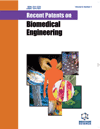- Home
- A-Z Publications
- Recent Patents on Biomedical Engineering (Discontinued)
- Previous Issues
- Volume 2, Issue 3, 2009
Recent Patents on Biomedical Engineering (Discontinued) - Volume 2, Issue 3, 2009
Volume 2, Issue 3, 2009
-
-
Recent Advances and Patents on Circulatory Support Devices for Pediatric Patients
More LessAuthors: Akira Shiose and Kiyotaka FukamachiRecent progress in medical management has significantly improved the range of treatments for children with severe heart failure; however, some patients still suffer from refractory heart failure, necessitating heart transplantation. Transplantation is the definitive therapy for end-stage heart failure in children and adults; however, many patients die before transplantation because of the shortage of donor organs. Mechanical c Read More
-
-
-
Noninvasive Monitoring of Intracranial Pressure
More LessAuthors: Djordje Popovic, Michael Khoo and Stefan LeeIncreased intracranial pressure (ICP) is one of the major causes of secondary brain ischemia that accompanies a variety of pathological conditions, most notably, traumatic brain injury (TBI), stroke, and intracranial hemorrhages. However, aside from a few Level I trauma centers, ICP monitoring is rarely a part of the clinical management of patients with these conditions because of the invasiveness of the standard monitoring met Read More
-
-
-
Review on Patents for Ubiquitin-Proteasome Inhibitor as Medical Advance in Major Human Diseases
More LessAuthors: Yongqiang Zhu and Qingzhi GaoThe ubiquitin-proteasome pathway (UPP) is the major proteolytic process that degrades the intracellular proteins in a regulated way. Deregulation of the UPP has been implicated in the pathogenesis of a number of major human diseases including cancer, viral infections, neurodegenerative disorder, cardiovascular disorder, diabetes, etc. The successful market of a patented drug bortezomib validated the proteasome as an e Read More
-
-
-
A New Method for Stimulating the Fertilizing Capability of Sperm Cells
More LessThe effects of visible light irradiation on various aspects of cell metabolism have been recognized in recent years, and extensive literature exists on the application of laser phototherapy in various biological systems. The biostimulative effect of light in the visible range has been attributed to minute amounts of light-induced reactive oxygen species (ROS) formation. In sperm cells, low amounts of ROS were found to enhance a Read More
-
-
-
Recent Advancements in Preventing Teeth Health Hazard: The Daily Use of Hydroxyapatite Instead of Fluoride
More LessAuthors: Norberto Roveri, Elisabetta Foresti, Marco Lelli and Isidoro G. LesciHydroxyapatite (HA) is commonly considered the most promising synthetic biomaterial for biomedical applications in orthopaedic, dental and maxillofacial surgery for its biocompatibility, bioresorption and bioactivity. Only recently a chemical-physical experimental approach has been utilized to investigate the capability of synthetic carbonated hydroxyapatite nanocrystals (CHA) to produce in vivo biomimetic mineral de Read More
-
-
-
Recent Developments on Citric Acid Derived Biodegradable Elastomers
More LessAuthors: Richard T. Tran, Yi Zhang, Dipendra Gyawali and Jian YangBiodegradable elastomers have recently found widespread application in many areas of biomedical engineering such as tissue engineering, drug delivery, and bioimaging. In particular, the recent developments in research have led to the creation of citric acid based polymers with enhanced mechanical properties, novel design strategies for crosslinking, nanoporous features, and unique photoluminescent capabilities. The pre Read More
-
-
-
Patent Selections
More LessThe patents annotated in this section have been selected from various patent databases. These recent patents are relevant to the articles published in this journal issue, categorized by medical imaging, bioinformatics, image processing, biomaterials, pharmaceutical drugs, bioengineering, medical devices, design, biological devices, biomechanics & diagnostic devices related to biomedical engineering.
-
Most Read This Month
Article
content/journals/biomeng
Journal
10
5
false
en


